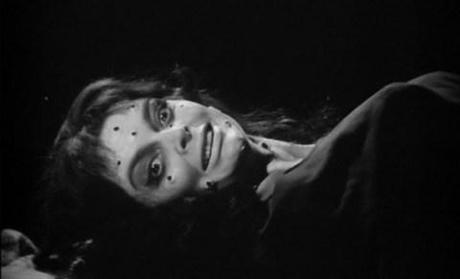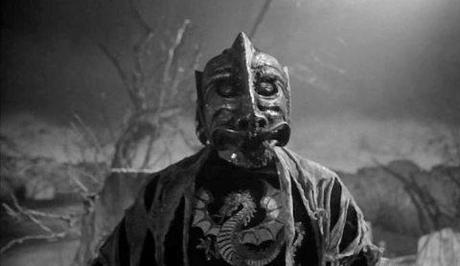
by Steve Habrat
Throughout the late 1950s and into the 1960s, gothic horror was alive and well in Europe. In the United States, interest in vampires, werewolves, and Frankenstein monsters faded in the wake of World War II and the atomic bomb. American horror movies moved on to mutated fiends, aliens from outer space, giant bugs stomping on small American towns, femme fatales, film noir, and Norman Bates slashers. Sure, Roger Corman released a few gothic drive-in Edgar Allen Poe tales starring Vincent Price, and there were a handful of witch-hunting films, but the emphasis was on monsters made through radiation, not in the pages of a Bram Stoker or Mary Shelley book. Europe was a completely different story. The British film company Hammer Films cranked out a number of classic gothic horror films, exploding in 1957 with The Curse of Frankenstein and continuing their run well into the 1970s. It seemed that Italy also had an interest in the gothic horror film, or at least Italian cinematographer turned director Mario Bava did. In 1960, Bava released Black Sunday (aka The Mask of Satan), a gorgeous gothic masterpiece centering on evil witches and bloodthirsty vampires coming back from their 200-year-old graves. Since its release, many critics have described Black Sunday as being a cross between a Hammer horror film and a classic Universal Studios horror film, an accurate description indeed. Featuring exquisite black and white cinematography, chilling sound work, unmatchable set design, an iconic performance from genre star Barbara Steele, and one of the most terrifying resurrection sequences in horror history, Black Sunday sits proudly near the top of the best Italian horror films of all time.
Black Sunday begins with a witch named Asa Vajda (played by Barbara Steele) and her vampire partner Javuto (played by Arturo Dominici) being sentenced to a gruesome death by Asa’s brother. Before the pair is left to burn, Asa’s brother orders that the mask of Satan be nailed to the faces of the condemned so that the world will forever know their true wickedness. Before they are executed, Asa puts a curse on her brother’s descendants and promises to return from the grave to have her revenge. Two centuries later, Dr. Thomas Kruvajan (played by Andrea Checchi) and his assistant, Dr. Andre Gorobec (played by John Richardson), are traveling through the same area where Asa and Javuto are buried. While passing through the eerie forest, one of their carriage wheels is damaged, leaving them stranded near Asa’s ruined tomb. While they wait for the wheel to be fixed, they decided to investigate the ruins to see what they can find. While poking around, the doctors find Asa’s coffin, which has a window displaying the horrible mask that was nailed to her face. Just as the men are about to leave the tomb, Dr. Kruvajan is attacked by a giant bat, which leaves a nasty cut on his hand. In the process of the attack, a few drops of blood make it into Asa’s tomb, resurrecting the evil witch and reigniting her fury. She telepathically resurrects Javuto, who sets out to find her brother’s descendants and make them pay.
If you were convinced that Hammer and Universal were the undisputed kings of gothic horror, Black Sunday is guaranteed to change your mind. There is not one scene in Black Sunday that doesn’t have some sort of gothic image to haunt your nightmares. There are cobwebbed tombs, dead forests, silhouetted castles, lifeless swamps, cracked graveyards, and crosses in every character’s hand. It’s full of the usual stuff, but the gothic style has never seemed so evil and dead as it does here. In Hammer and Universal’s offerings, there were at least a few glimpses of life, maybe a few late autumn leaves stuck to a branch or a babbling brook, but not in Black Sunday. It appears Asa’s curse worked its way into the trees, soil, and even the castle stones, leaving a perpetually parched and still wasteland where nothing will ever grow. It’s extremely creepy and it looks absolutely amazing in Bava’s lush black and white cinematography. You’d think that when compared to Hammer’s color releases, Black Sunday would be overlooked due to being presented in black and white, but the lack of color only adds to the hopelessness of the surroundings. It also adds extra menace to the shadowy castle hallways and rotten tombs, where candelabras flicker and tapestries hang down like fangs waiting to snap.

While Black Sunday may be celebrated for its gothic style, the film is also loaded with spectacular performances, particularly from Barbara Steele in a dual role. As Asa, Steele is in completely command of the film as she curses, and manipulates anyone who dares look in her direction. When we first see her tied to the stake waiting to be burned, her beauty throws us. We hear her brother condemning her for these terrible actions, but her innocent eyes hold us in doubt. Could she really be responsible for what they say she is? Don’t be fooled, as her true nature soon rears its ugly head. When Steele isn’t projecting pure evil as the vengeful witch, she is showing us her softer side as Katia, a striking descendent of Asa’s brother. Her performance as Katia doesn’t hit quite as hard as Asa, as she is basically asked to sit by her father’s bedside, look worried, or play the damsel in distress, but it’s still strong where it counts. Arturo Dominici gives a strong and silent performance as the equally wicked Javuto, Asa’s vampire partner who carries out some of the dirty work for the witch. When he speaks, you will be turned to stone. John Richardson’s Dr. Gorobec basically becomes the hero and love interest of Katia, Andrea Checchi’s Dr. Kruvajan becomes hypnotized servant to Asa, and Antonio Pierfederici’s Priest demonstrates a very creative and gruesome way to dispatch a vampire.
Despite the long list of positives, Black Sunday still has a few minor flaws that are difficult to ignore. First is the dubbing, which opens the door for some less-than-graceful dialog. Unlike some of the trashier Italian efforts that would come much later, Bava makes an effort to have the English dubbing match the movement of the character’s mouths. It’s a success in that regard, but there are times when you wish that the film had been subtitled. Another minor problem with the film is the score, which slightly conflicts with Bava’s stunningly grim imagery. The music for the American version of Black Sunday was provided by Les Baxter, who delivers a score that captures none of the gothic atmosphere that flows forth from the screen. Still, the complaints are trivial when compared to both of the terrifying resurrection sequences, the unblinking gore, our first glimpse of Katia, or the chilly opening execution. They are all glimmers of absolute brilliance. Overall, as stylish, eerie, and grotesque as they come, Black Sunday is an astonishing directorial debut by the legendary Mario Bava. To this day, his images still retain their hair-raising power, and Steele’s Asa still stands as one of the most evil forces to ever haunt a movie screen.
Grade: A
Black Sunday is available on Blu-ray and DVD.
